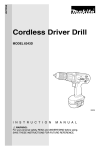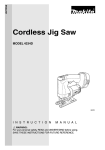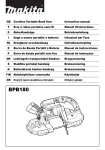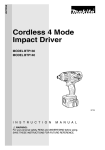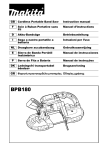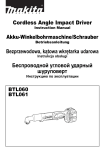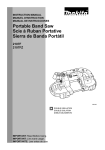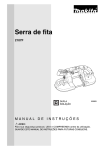Download Makita BPB180 Specifications
Transcript
ENGLISH Cordless Portable Band Saw MODEL BPB180 007297 I N S T R U C T I O N M A N U A L WARNING: For your personal safety, READ and UNDERSTAND before using. SAVE THESE INSTRUCTIONS FOR FUTURE REFERENCE. SPECIFICATIONS Model BPB180 Round workpiece 120 mm dia. Rectangular workpiece 120 mm x 120 mm Max. cutting capacity Blade speed 1.4 - 2.7 m/s Length Blade size 1,140 mm Width 13 mm Thickness 0.5 mm Overall dimensions (L x W x H) 523 mm x 231 mm x 313 mm Net weight 6.4 kg Rated voltage D.C. 18 V • Due to our continuing programme of research and development, the specifications herein are subject to change without notice. • Note: Specifications may differ from country to country. END001-1 For European countries only Noise and Vibration Symbols The typical A-weighted sound pressure level is 77 dB (A). The following show the symbols used for the equipment. Uncertainty is 3 dB(A). Be sure that you understand their meaning before use. The noise level under working may exceed 85 dB (A). – Wear ear protection. – ..................Only for EU countries The typical weighted root mean square acceleration Do not dispose of electric equipment value is not more than 2.5 m/s2. together with household waste These values have been obtained according to material! EN60745. In observance of European Directive 2002/96/EC on waste electric and EC-DECLARATION OF CONFORMITY electronic equipment and its We declare under our sole responsibility that this prodimplementation in accordance with uct is in compliance with the following standards of stannational law, electric equipment that dardized documents; have reached the end of their life EN60745, EN55014 in accordance with Council Direcmust be collected separately and tives, 89/336/EEC, 98/37/EC. returned to an environmentally compatible recycling facility. Yasuhiko Kanzaki CE2005 Intended use The tool is intended for cutting in wood, plastic and ferrous materials. Director MAKITA INTERNATIONAL EUROPE LTD. Michigan Drive, Tongwell, Milton Keynes, Bucks MK15 8JD, ENGLAND Responsible manufacturer: Makita Corporation Anjo Aichi Japan 2 GENERAL SAFETY RULES GEA002-3 WARNING: Read all instructions. Failure to follow all instructions listed below may result in electric shock, fire and/or serious injury. The term “power tool” in all of the warnings listed below refers to your mains-operated (corded) power tool or battery-operated (cordless) power tool. SAVE THESE INSTRUCTIONS. Work area safety 1. Keep work area clean and well lit. Cluttered and dark areas invite accidents. 2. Do not operate power tools in explosive atmospheres, such as in the presence of flammable liquids, gases or dust. Power tools create sparks which may ignite the dust or fumes. 3. Keep children and bystanders away while operating a power tool. Distractions can cause you to lose control. Electrical safety 4. Power tool plugs must match the outlet. Never modify the plug in any way. Do not use any adapter plugs with earthed (grounded) power tools. Unmodified plugs and matching outlets will reduce risk of electric shock. 10. Use safety equipment. Always wear eye protection. Safety equipment such as dust mask, non-skid safety shoes, hard hat, or hearing protection used for appropriate conditions will reduce personal injuries. 11. Avoid accidental starting. Ensure the switch is in the off-position before plugging in. Carrying power tools with your finger on the switch or plugging in power tools that have the switch on invites accidents. 12. Remove any adjusting key or wrench before turning the power tool on. A wrench or a key left attached to a rotating part of the power tool may result in personal injury. 13. Do not overreach. Keep proper footing and balance at all times. This enables better control of the power tool in unexpected situations. 5. Avoid body contact with earthed or grounded surfaces such as pipes, radiators, ranges and refrigerators. There is an increased risk of electric shock if your body is earthed or grounded. 14. Dress properly. Do not wear loose clothing or jewellery. Keep your hair, clothing, and gloves away from moving parts. Loose clothes, jewellery or long hair can be caught in moving parts. 6. Do not expose power tools to rain or wet conditions. Water entering a power tool will increase the risk of electric shock. 7. Do not abuse the cord. Never use the cord for carrying, pulling or unplugging the power tool. Keep cord away from heat, oil, sharp edges or moving parts. Damaged or entangled cords increase the risk of electric shock. 15. If devices are provided for the connection of dust extraction and collection facilities, ensure these are connected and properly used. Use of these devices can reduce dust-related hazards. 8. When operating a power tool outdoors, use an extension cord suitable for outdoor use. Use of a cord suitable for outdoor use reduces the risk of electric shock. Personal safety 9. Stay alert, watch what you are doing and use common sense when operating a power tool. Do not use a power tool while you are tired or under the influence of drugs, alcohol or medication. A moment of inattention while operating power tools may result in serious personal injury. Power tool use and care 16. Do not force the power tool. Use the correct power tool for your application. The correct power tool will do the job better and safer at the rate for which it was designed. 17. Do not use the power tool if the switch does not turn it on and off. Any power tool that cannot be controlled with the switch is dangerous and must be repaired. 18. Disconnect the plug from the power source and/ or the battery pack from the power tool before making any adjustments, changing accessories, or storing power tools. Such preventive safety measures reduce the risk of starting the power tool accidentally. 3 19. Store idle power tools out of the reach of children and do not allow persons unfamiliar with the power tool or these instructions to operate the power tool. Power tools are dangerous in the hands of untrained users. 20. Maintain power tools. Check for misalignment or binding of moving parts, breakage of parts and any other condition that may affect the power tools operation. If damaged, have the power tool repaired before use. Many accidents are caused by poorly maintained power tools. 21. Keep cutting tools sharp and clean. Properly maintained cutting tools with sharp cutting edges are less likely to bind and are easier to control. 22. Use the power tool, accessories and tool bits etc. in accordance with these instructions and in the manner intended for the particular type of power tool, taking into account the working conditions and the work to be performed. Use of the power tool for operations different from those intended could result in a hazardous situation. Battery tool use and care 23. Ensure the switch is in the off position before inserting battery pack. Inserting the battery pack into power tools that have the switch on invites accidents. 24. Recharge only with the charger specified by the manufacturer. A charger that is suitable for one type of battery pack may create a risk of fire when used with another battery pack. 25. Use power tools only with specifically designated battery packs. Use of any other battery packs may create a risk of injury and fire. 26. When battery pack is not in use, keep it away from other metal objects like paper clips, coins, keys, nails, screws, or other small metal objects that can make a connection from one terminal to another. Shorting the battery terminals together may cause burns or a fire. 27. Under abusive conditions, liquid may be ejected from the battery, avoid contact. If contact accidentally occurs, flush with water. If liquid contacts eyes, additionally seek medical help. Liquid ejected from the battery may cause irritation or burns. Service 28. Have your power tool serviced by a qualified repair person using only identical replacement parts. This will ensure that the safety of the power tool is maintained. 29. Follow instruction for lubricating and changing accessories. 30. Keep handles dry, clean and free from oil and grease. SPECIFIC SAFETY RULES GEB005-3 DO NOT let comfort or familiarity with product (gained from repeated use) replace strict adherence to portable band saw safety rules. If you use this tool unsafely or incorrectly, you can suffer serious personal injury. 1. Use only blades which are 1,140 mm (44-7/8”) long, 13 mm (1/2”) wide, and 0.5 mm (.020”) thick. 6. Do not wear gloves during operation. 7. Hold the tool firmly with both hands. 8. Keep hands away from rotating parts. 9. When cutting metal, be cautious of hot flying chips. 2. Check the blade carefully for cracks or damage before operation. Replace cracked or damaged blade immediately. 3. Secure the workpiece firmly. When cutting a bundle of workpieces, be sure that all workpieces are secured together firmly before cutting. 10. Do not leave the tool running unattended. 4. Cutting workpieces covered with oil can cause the blade to come off unexpectedly. Wipe off all excess oil from workpieces before cutting. 5. Never use the cutting oil as a cutting lubricant. Use only Makita cutting wax. 12. Hold power tools by insulated gripping surfaces when performing an operation where the cutting tool may contact hidden wiring or its own cord. Contact with a “live” wire will make exposed metal parts of the tool “live” and shock the operator. 4 11. Do not touch the blade or the workpiece immediately after operation; they may be extremely hot and could burn your skin. SAVE THESE INSTRUCTIONS WARNING: MISUSE or failure to follow the safety rules stated in this instruction manual may cause serious personal injury. (3) ENC007-2 IMPORTANT SAFETY INSTRUCTIONS 6. FOR BATTERY CARTRIDGE 1. 2. 3. 4. 5. Before using battery cartridge, read all instructions and cautionary markings on (1) battery charger, (2) battery, and (3) product using battery. Do not disassemble battery cartridge. If operating time has become excessively shorter, stop operating immediately. It may result in a risk of overheating, possible burns and even an explosion. If electrolyte gets into your eyes, rinse them out with clear water and seek medical attention right away. It may result in loss of your eyesight. Do not short the battery cartridge: (1) Do not touch the terminals with any conductive material. (2) Avoid storing battery cartridge in a container with other metal objects such as nails, coins, etc. 7. 8. Do not expose battery cartridge to water or rain. A battery short can cause a large current flow, overheating, possible burns and even a breakdown. Do not store the tool and battery cartridge in locations where the temperature may reach or exceed 50°C (122°F). Do not incinerate the battery cartridge even if it is severely damaged or is completely worn out. The battery cartridge can explode in a fire. Be careful not to drop or strike battery. SAVE THESE INSTRUCTIONS. Tips for maintaining maximum battery life 1. 2. 3. Charge the battery cartridge before completely discharged. Always stop tool operation and charge the battery cartridge when you notice less tool power. Never recharge a fully charged battery cartridge. Overcharging shortens the battery service life. Charge the battery cartridge with room temperature at 10°C - 40°C (50°F - 104°F). Let a hot battery cartridge cool down before charging it. 5 FUNCTIONAL DESCRIPTION • 007146 Installing or removing battery cartridge • 1 2 • • 3 1. Battery cartridge 2. Button 3. Red part CAUTION: Always be sure that the tool is switched off and the battery cartridge is removed before adjusting or checking function on the tool. • Always switch off the tool before insertion or removal of the battery cartridge. To remove the battery cartridge, withdraw it from the tool while sliding the button on the front of the cartridge. To insert the battery cartridge, align the tongue on the battery cartridge with the groove in the housing and slip it into place. Always insert it all the way until it locks in place with a little click. If you can see the red part on the lower side of the button, it is not locked completely. Insert it fully until the red part cannot be seen. If not, it may accidentally fall out of the tool, causing injury to you or someone around you. Do not use force when inserting the battery cartridge. If the cartridge does not slide in easily, it is not being inserted correctly. 007147 Switch action B CAUTION: Before inserting the battery cartridge into the tool, always check to see that the switch trigger actuates properly and returns to the “OFF” position when released. To prevent the switch trigger from accidentally pulled, the lock-off button is provided. To start the tool, depress the lock-off button from B side and pull the switch trigger. Release the switch trigger to stop. After use, always press in the lock-off button from A side. 1 • A 2 1. Lock-off button 2. Switch trigger 007148 1 Speed adjusting dial The tool speed can be infinitely adjusted between 1.4 m/s and 2.7 m/s by turning the adjusting dial. Higher speed is obtained when the dial is turned in the direction of number 6; lower speed is obtained when it is turned in the direction of number 1. Select the proper speed for the workpiece to be cut. • 1. Speed adjusting dial 6 CAUTION: The speed adjusting dial can be turned only as far as 6 and back to 1. Do not force it past 6 or 1, or the speed adjusting function may no longer work. 007149 Lighting up the lamp CAUTION: Do not apply impact to the lamp, which may cause damage or shorted service time to it. Pull the switch trigger to light up the lamp. The lamp keeps on lighting while the switch trigger is being pulled. The lamp goes out 10 -15 seconds after releasing the trigger. • 1 NOTE: 1. Lamp • • • • ASSEMBLY • Use a dry cloth to wipe the dirt off the lens of lamp. Be careful not to scratch the lens of lamp, or it may lower the illumination. Do not use thinner or gasoline to clean the lamp. Such solvents may damage it. When the tool is overloaded during operation, the lamp flickers. When the remaining battery capacity becomes small, the lamp flickers. CAUTION: Always be sure that the tool is switched off and the battery cartridge is removed before carrying out any work on the tool. Installing or removing the blade • • 007299 4 1 CAUTION: Oil on the blade can cause the blade to slip or come off unexpectedly. Wipe off all excess oil with a cloth before installing the blade. Use caution when handling the blade so that you are not cut by the sharp edge of the blade teeth. Turn the blade tightening lever clockwise until it hits against the protrusion on the frame. 2 3 1. 2. 3. 4. Tighten Loosen Protrusion Lever 7 006192 3 1 Match the direction of the arrow on the blade to that of the arrow on the wheels. 4 2 1. 2. 3. 4. Blade Bearing Upper holder Lower holder 006193 3 2 1 4 1. 2. 3. 4. Upper holder Lower holder Wheel Press Position the blade around the wheels and insert the other side of the blade within the upper holder and lower holder until the blade back contacts the bottom of the upper holder and lower holder. Hold the blade in place and turn the blade-tightening lever counterclockwise until it hits against the protrusion on the frame. This places proper tension on the blade. Make sure that the blade is correctly positioned within the blade guard and around the wheels. Start and stop the tool two or three times to make sure that the blade runs properly on the wheels. CAUTION: While making sure that the blade runs on the wheels properly, keep your body away from the blade area. To remove the blade, follow the installation procedure in reverse. • • 007151 1 3 2 1. Screw 2. Stopper plate 3. Blade 8 B A CAUTION: When turning the blade tightening lever clockwise to release the tension on the blade, point the tool downward because the blade may come off unexpectedly. Adjusting the protrusion of stopper plate In the ordinary operation, protrude the stopper plate to the A side fully. When the stopper plate strikes against the obstacles like a wall or the like at the finishing of a cut, loosen two screws and slide it to the B side in the figure. After sliding the stopper plate, secure it by tightening two screws firmly. OPERATION 007316 It is important to keep at least two teeth in the cut. Select the proper cutting position for your workpiece by referring to the figure. 004747 007301 Hold the tool by both hands as shown in the figure with the stopper plate contacting the workpiece and the blade clear of the workpiece. Turn the tool on and wait until the blade attains full speed. Gently lower the blade into the cut. The weight of the tool or slightly pressing the tool will supply adequate pressure for the cutting. Do not force the tool. As you reach the end of a cut, release pressure and, without actually raising the tool, lift it slightly so that it will not fall against the workpiece. • • • CAUTION: Applying excessive pressure to the tool or twisting of the blade may cause bevel cutting or damage to the blade. When not using the tool for a long period of time, remove the blade from the tool. If the tool is operated continuously until the battery cartridge has discharged, allow the tool to rest for 15 minutes before proceeding with a fresh battery. Cutting lubricant 007298 1 When cutting metals, use Makita cutting wax as a cutting lubricant. To apply the cutting wax to the blade teeth, start the tool and cut in to the cutting wax as shown in the figure after removing a cap of the cutting wax. • • CAUTION: Never use cutting oil or apply excessive amount of wax to the blade. It may cause the blade to slip or come off unexpectedly. When cutting cast iron, do not use any cutting wax. 1. Cutting wax 9 MAINTENANCE • CAUTION: Always be sure that the tool is switched off and the battery cartridge is removed before attempting to perform inspection or maintenance. Cleaning After use, remove wax, chips and dust from the tool, wheel tires and blade. • • 004750 CAUTION: Never use solvents such as turpentine, gasoline, lacquer, etc. to clean plastic parts. Wax and chips on the tires may cause the blade to slip and come off unexpectedly. Use a dry cloth to remove wax and chips from the tires. Replacing tires on wheels When the blade slips or does not track properly because of badly worn tires, or the lip of the tire on motor side gets damaged, the tires should be replaced. 1 2 3 1. Wheel 2. Tire 3. Lip 001145 Replacing carbon brushes Remove and check the carbon brushes regularly. Replace when they wear down to the limit mark. Keep the carbon brushes clean and free to slip in the holders. Both carbon brushes should be replaced at the same time. Use only identical carbon brushes. 1 1. Limit mark 007302 1 2 1. Screwdriver 2. Brush holder cap 10 Use a screwdriver to remove the brush holder caps. Take out the worn carbon brushes, insert the new ones and secure the brush holder caps. To maintain product SAFETY and RELIABILITY, repairs, any other maintenance or adjustment should be performed by Makita Authorized Service Centers, always using Makita replacement parts. ACCESSORIES CAUTION: These accessories or attachments are recommended for use with your Makita tool specified in this manual. The use of any other accessories or attachments might present a risk of injury to persons. Only use accessory or attachment for its stated purpose. If you need any assistance for more details regarding these accessories, ask your local Makita Service Center. • • • Band saw blades Hex wrench 4 • • Cutting wax Various type of Makita genuine batteries and chargers 11 Makita Corporation Anjo, Aichi, Japan 884663-224












